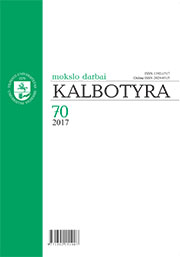English and Croatian citation practices in research articles in applied linguistics: a corpus-based study
English and Croatian citation practices in research articles in applied linguistics: a corpus-based study
Author(s): Mirna Varga, Tanja GradečakSubject(s): Pragmatics, Comparative Linguistics, Sociolinguistics, Sociology of Culture
Published by: Vilniaus Universiteto Leidykla
Keywords: citation; academic writing; research article; English; Croatian;
Summary/Abstract: As a mandatory constituent of academic writing, citation allows writers to acknowledge other scholarsʼ work and to position their research against it, showing thus both contribution to previous knowledge and research novelty (Hyland 2004). Previous research has documented not only cross-disciplinary (Hyland 2004) but also cross-cultural variations, with a general tendency of Anglo-American writers to use more citations than writers of some other cultural backgrounds (Hyland 2005; Mur Dueñas 2009). By exploring the frequency, preferred types, and reporting structures of citations in two comparable sub-corpora of research articles in applied linguistics in English and Croatian, the present study aimed to provide an insight into the patterns of cross-cultural similarities and differences in the use of academic citation. The corpus comprised 32 research articles that were sampled from the representative English- and Croatian-medium publications in applied linguistics and analyzed manually. The extracted instances of citations were categorized according to the pre-established taxonomies of the citation types (Swales, 1990) and reporting structures in academic writing (Thomson & Tribble 2001). The frequency analysis showed that the English writers used more citations as opposed to the Croatian writers, which is in line with previous cross-cultural research on the use of citations (Fløttum, Dahl & Kinn 2006; Mur Dueñas 2009). In both sub-corpora writers used more non-integral than integral citations, with the highest frequencies reported in the Introduction section of research articles. The overall findings point to the saliency of the congruent types of reporting structures in both citation formats across the two sub-corpora, with the human subjects being most frequently used in integral citations and non-reporting being the most frequent reporting structure in non-integral citations. However, in non-integral citations English writers used non-human subjects at a significantly higher frequency than Croatian writers, which suggests that in the English citations investigated more importance is placed on research activities than human agents. Whereas similarities in the use of citations between English and Croatian writers may be accounted for by the congruent disciplinary variable, the differences seem to be related to the specifics of a wider socio-cultural background in which academic writing is embedded.
Journal: Kalbotyra
- Issue Year: 2017
- Issue No: 70
- Page Range: 153-183
- Page Count: 31
- Language: English

